Long-Lead-Time Prediction of Storm Surge Using Artificial Neural Networks and Effective Typhoon Parameters: Revisit and Deeper Insight
Abstract
1. Introduction
2. Description of Study Site and Data Collection
3. BPNN Forecasting Model and Knowledge Extraction Method
3.1. Effective Controlling Parameters
3.2. Back-Propagation Neural Network (BPNN)
3.3. Knowledge Extraction Method (KEM)
4. Results and Discussion
4.1. One-hour Ahead Prediction
4.2. Roles of Hidden Neurons
4.3. Contributions of Controlling Parameters
4.4. Knowledge of the Neural Network
4.5. Long-Lead-Time Prediction
5. Conclusions
Author Contributions
Funding
Acknowledgments
Conflicts of Interest
References
- Doodson, A.T. Tides and storm surges in a long uniform gulf. Proc. Math. Phys. Eng. Sci. 1956, 237, 325–343. [Google Scholar]
- Conner, W.C.; Kraft, K.H.; Harris, D.L. Empirical methods for forecasting the maximum storm tide due to hurricanes and other tropical storms. Mon. Weather Rev. 1957, 85, 113–116. [Google Scholar] [CrossRef]
- Wolf, J.; Flather, R.A. Modelling waves and surges during the 1953 storm. Philos. Trans. R. Soc. A 2005, 363, 1359–1375. [Google Scholar] [CrossRef]
- Piekle, R.A., Jr.; Gratz, J.; Landsea, C.W.; Collins, D.; Saunders, M.A.; Musulin, R. Normalized hurricane damage in the United States: 1900–2005. Nat. Hazards Rev. 2008, 9, 29–42. [Google Scholar]
- Webster, P.J.; Holland, G.J.; Curry, J.A.; Chang, H.R. Changes in tropical cyclone number, duration, and intensity in a warming environment. Science 2005, 309, 1844–1846. [Google Scholar] [CrossRef]
- Emanuel, K.A. Increasing destructiveness of tropical cyclones over the past 30 years. Nature 2005, 436, 686–688. [Google Scholar] [CrossRef]
- IPCC. Climate Change 2007: Impacts, Adaptation and Vulnerability. Contribution of Working Group II to the Fourth Assessment Report of the Intergovernmental Panel on Climate Change; Parry, M.L., Canziani, O.F., Palutikof, J.P., van der Linden, P.J., Hanson, C.E., Eds.; Cambridge University Press: Cambridge, UK, 2007; p. 976. [Google Scholar]
- Lin, N.; Emanuel, K.A.; Smith, J.A.; Vanmarcke, E. Risk assessment of hurricane storm surge for New York City. J. Geophys. Res. 2010, 115, D18121. [Google Scholar] [CrossRef]
- Sheng, Y.P.; Davis, J.R.; Figueiredo, R.; Liu, B.; Liu, H.; Luettich, R., Jr.; Paramygin, V.A.; Weaver, R.; Weisberg, R.; Xie, L.; et al. A regional testbed for storm surge and inundation models. In Proceedings of the 12th International Conference on Estuarine and Coastal Modeling, St. Augustine, FL, USA, 7–9 November 2011; pp. 479–495. [Google Scholar]
- Kim, S.Y.; Matsumi, Y.; Pan, S.; Mase, H. A real-time forecast model using artificial neural network for after runner storm surges on the Tottori coast, Japan. Ocean Eng. 2016, 122, 44–53. [Google Scholar] [CrossRef]
- Hashemi, M.R.; Spaulding, M.; Shaw, A.; Farhadi, H.; Lewis, M. An efficient artificial intelligence model for prediction of tropical storm surge. Nat. Hazards 2016, 82, 471–491. [Google Scholar] [CrossRef]
- Wu, G.; Shi, F.; Kirby, J.T.; Liang, B.; Shi, J. Modeling wave effects on storm surge and coastal inundation. Coast. Eng. 2018, 140, 371–382. [Google Scholar] [CrossRef]
- Torres, M.J.; Hashemi, M.R.; Hayward, S.; Spaulding, M.; Ginis, I.; Grilli, S.T. Role of hurricane wind models in accurate simulation of storm surge and waves. J. Waterw. Port Coast. Ocean Eng. 2019, 145, 04018039. [Google Scholar] [CrossRef]
- Flather, R.A. Storm surges. In Encyclopaedia of Ocean Science; Steele, J., Thorpe, S., Turekian, K., Eds.; Academia: San Diego, CA, USA, 2001; pp. 2882–2892. [Google Scholar]
- Welander, P. Numerical predictions of storm surges. Adv. Geophys. 1961, 8, 315–379. [Google Scholar]
- Lee, T.L. Neural network prediction of a storm surge. Ocean Eng. 2006, 33, 483–494. [Google Scholar] [CrossRef]
- Hoover, R.A. Empirical Relationships of the Central Pressures in Hurricanes to the Maximum Surge and Storm Tide. Mon. Weather Rev. 1957, 85, 167–174. [Google Scholar] [CrossRef]
- Horikawa, K. Coastal Engineering: An Introduction to Ocean Engineering; University of Tokyo Press: Tokyo, Japan, 1978. [Google Scholar]
- Tilburg, C.E.; Garvine, R.W. A simple model for coastal sea level prediction. Weather Forecast. 2004, 19, 511–519. [Google Scholar] [CrossRef]
- Jan, C.D.; Tseng, C.M.; Wang, J.S.; Cheng, Y.H. Empirical relation between the typhoon surge deviation and the corresponding typhoon characteristics: A case study in Taiwan. J. Mar. Sci. Technol. 2006, 11, 193–200. [Google Scholar] [CrossRef]
- Tsai, C.P.; You, C.Y. Development of models for maximum and time variation of storm surges at the Tanshui estuary. Nat. Hazards Earth Syst. Sci. 2014, 14, 2313–2320. [Google Scholar] [CrossRef]
- Van Dantzig, D. Mathematical problems raised by the flood disaster 1953. In Proceedings of the International Congress of Mathematics, Amsterdam, The Netherlands, 2–9 September 1954; pp. 218–239. [Google Scholar]
- Platzman, G.W. The dynamical prediction of wind tides on Lake Erie. Meteorol. Monogr. 1963, 4, 1–44. [Google Scholar]
- Jelesnianski, C.P. A numerical calculation of storm tides induced by a tropical storm impinging on a continental shelf. Mon. Weather Rev. 1965, 93, 343–358. [Google Scholar] [CrossRef]
- Holland, G.J. An analytic model of the wind and pressure profiles in hurricanes. Mon. Weather Rev. 1980, 108, 1212–1218. [Google Scholar] [CrossRef]
- Jelesnianski, C.P.; Chen, J.; Shaffer, W.A. SLOSH: Sea, Lake, and Overland Surges from Hurricanes; NOAA Technical Report NWS 48; National Oceanic and Atmospheric Administration, U.S. Department of Commerce: Silver Spring, MD, USA, 1992; pp. 1–71.
- Bode, L.; Hardy, T.A. Progress and recent developments in storm surge modeling. J. Hydraul. Eng. 1997, 123, 315–331. [Google Scholar] [CrossRef]
- Dietrich, J.C.; Zijlema, M.; Westerink, J.; Holthuijsen, L.; Dawson, C.; Luettich, R.A., Jr.; Jensen, R.E.; Smith, J.M.; Stelling, G.S.; Chen, G.W. Modeling hurricane waves and storm surge using integrally coupled scalable computations. Coast. Eng. 2011, 58, 45–65. [Google Scholar] [CrossRef]
- Kohno, N.; Dube, S.K.; Entel, M.; Fakhruddin, S.H.M.; Greenslade, D.; Leroux, M.D.; Rhome, J.; Thuy, N.B. Recent progress in storm surge forecasting. Trop. Cyclone Res. Rev. 2018, 7, 128–139. [Google Scholar]
- Houston, S.H.; Shaffer, W.A.; Powell, M.D.; Chen, J. Comparisons of HRD and SLOSH surface wind fields in hurricanes: Implications for storm surge modeling. Weather Forecast. 1999, 14, 671–686. [Google Scholar] [CrossRef]
- Skamarock, W.C.; Klemp, J.B.; Dudhia, J.; Gill, D.O.; Barker, D.M.; Duda, M.G.; Huang, X.Y.; Wang, W.; Powers, J.G. A Description of the Advanced Research WRF Version 3; NCAR Technical Note NCAR/TN-475+STR; Mesoscale and Microscale Meteorology Division, National Center for Atmospheric Research: Boulder, CO, USA, 2008. [Google Scholar]
- Holland, G.J.; Belanger, J.I.; Fritz, A. A revised model for radial profiles of hurricane winds. Mon. Weather Rev. 2010, 138, 4393–4406. [Google Scholar] [CrossRef]
- Rego, J.L.; Li, C. On the receding of storm surge along Louisiana’s low-lying coast. J. Coast. Res. 2009, 56, 1042–1049. [Google Scholar]
- Das, Y.; Mohanty, U.C.; Jain, I. Development of tropical cyclone wind field for simulation of storm surge/sea surface height using numerical ocean model. Model Earth Syst. Environ. 2016, 2, 13. [Google Scholar] [CrossRef][Green Version]
- Dietrich, J.C.; Muhammad, A.; Curcic, M.; Fathi, A.; Dawson, C.N.; Chen, S.S.; Luettich, R.A. Sensitivity of storm surge predictions to atmospheric forcing during Hurricane Isaac. J. Waterw. Port Coast. Ocean Eng. 2018, 144, 04017035. [Google Scholar] [CrossRef]
- Sheng, Y.P. Validation and recent enhancement of a three-dimensional curvilinear-grid finite-difference model for estuarine, coastal and lake circulation: CH3D. In Estuarine and Coastal Modeling; American Society of Civil Engineering: New York, NY, USA, 1990; pp. 1097–1103. [Google Scholar]
- Weserink, J.J.; Luettich, R.A.; Baptista, A.M.; Scheffner, N.W.; Farrar, P. Tide and storm surge predictions using a finite element model. J. Hydraul. Eng. 1992, 118, 1373–1390. [Google Scholar] [CrossRef]
- Plüß, A.; Rudolph, E.; Schrödter, D. Characteristics of storm surges in german estuaries. Clim. Res. 2001, 18, 71–76. [Google Scholar] [CrossRef]
- Hsu, T.W.; Liao, J.M.; Lee, Z.S. Prediction of storm surge at northern coast of Taiwan by finite element method. Chin. Inst. Civ. Hydraul. Eng. 1999, 11, 849–857. (In Chinese) [Google Scholar]
- Shen, J.; Zhang, K.; Xiao, C.; Gong, W. Improved prediction of storm surge inundation with a high-resolution unstructured grid model. J. Coast Res. 2006, 22, 1309–1319. [Google Scholar] [CrossRef]
- Zhang, W.Z.; Hong, H.S.; Shang, S.P.; Chen, D.W.; Chai, F. A two-way nested coupled tide-surge model for the Taiwan Strait. Cont. Shelf Res. 2007, 27, 1548–1567. [Google Scholar] [CrossRef]
- Jones, J.E.; Davies, A.M. Influence of Non-linear Effects upon Surge Elevations along the West Coast of Britain. Ocean Dyn. 2007, 57, 401–416. [Google Scholar] [CrossRef]
- Weisberg, R.H.; Zheng, L. Hurricane storm surge simulations comparing three-dimensional with two-dimensional formulations based on an Ivan-like storm over the Tampa Bay, Florida region. J. Geophys. Res. 2008, 113, C12001. [Google Scholar] [CrossRef]
- Sheng, Y.P.; Paramygin, V.A. Forecasting storm surge, inundation, and 3D circulation along the Florida Coast, Estuarine and Coastal Modeling. In Proceedings of the 11th International Conference ASCE, Fort Lauderdale, FL, USA, 20–22 May 2010; pp. 744–761. [Google Scholar]
- Kodaira, T.; Thompson, K.R.; Bernier, N.B. Prediction of M2 tidal surface currents by a global baroclinic ocean model and evaluation using observed drifter trajectories. J. Geophys. Res. Oceans 2016, 121, 6159–6183. [Google Scholar] [CrossRef]
- Kim, S.Y.; Yasuda, T.; Mase, H. Numerical analysis of effects of tidal variations on storm surges and waves. Appl. Ocean Res. 2008, 30, 311–322. [Google Scholar] [CrossRef]
- Chen, W.B.; Liu, W.C.; Hsu, M.H. Computational investigation of typhoon-induced storm surges along the coast of Taiwan. Nat. Hazards 2012, 64, 1161–1185. [Google Scholar] [CrossRef]
- Brown, J.M.; Souza, A.J.; Wolf, J. An 11-year validation of wave-surge modelling in the Irish Sea, using a nested POLCOMS-WAM modelling system. Ocean Model. 2010, 33, 118–128. [Google Scholar] [CrossRef]
- Chen, S.S.; Zhao, W.; Donelan, M.A.; Tolman, H.L. Directional wind-wave coupling in fully coupled atmosphere-wave-ocean models: Results from CBLAST-hurricane. J. Atmos. Sci. 2013, 70, 3198–3215. [Google Scholar] [CrossRef]
- Chen, W.B.; Lin, L.Y.; Jang, J.H.; Chang, C.H. Simulation of typhoon-induced storm tides and wind waves for the northeastern coast of Taiwan using a tide–surge–wave coupled model. Water 2017, 9, 549. [Google Scholar] [CrossRef]
- Hong, J.S.; Moon, J.H.; Kim, T.; Lee, J.H. Impact of ocean–wave coupling on typhoon-induced waves and surge levels around the Korean Peninsula: A case study of Typhoon Bolaven. Ocean Dyn. 2018, 68, 1543–1557. [Google Scholar] [CrossRef]
- Tsai, C.P.; Lee, T.L. Back-propagation neural network in tidal level forecasting. J. Waterw. Port Coast. Ocean Eng. 1999, 125, 195–202. [Google Scholar] [CrossRef]
- Oliveiria, M.M.F.D.; Ebecken, N.F.F.; Oliveria, J.L.F.D.; Santos, I.D.A. Neural network model to predict a storm surge. J. Appl. Meteorol. Climatol. 2009, 48, 143–155. [Google Scholar] [CrossRef]
- You, S.H.; Seo, J.W. Storm surge prediction using an artificial neural network model and cluster analysis. Nat. Hazards 2009, 51, 97–114. [Google Scholar] [CrossRef]
- Lee, T.L. Back-propagation neural network for long-term tidal predictions. Ocean Eng. 2004, 31, 225–238. [Google Scholar] [CrossRef]
- Rumelhart, D.E.; Hinton, G.E.; Williams, R.J. Learning representations by back-propagating errors. Nature 1986, 323, 533–536. [Google Scholar] [CrossRef]
- Bajo, M.; Umgiesser, G. Storm surge forecast through a combination of dynamic and neural network models. Ocean Model 2010, 33, 1–9. [Google Scholar] [CrossRef]
- Erdil, A.; Arcaklioglu, E. The prediction of meteorological variables using artificial neural network. Neural. Comput. Appl. 2013, 22, 1677–1683. [Google Scholar] [CrossRef]
- Young, C.C.; Liu, W.C. Prediction and modelling of rainfall–runoff during typhoon events using a physically-based and artificial neural network hybrid model. Hydrolog. Sci. J. 2015, 60, 2102–2116. [Google Scholar] [CrossRef]
- Young, C.C.; Liu, W.C.; Chang, C.E. Genetic algorithm and fuzzy neural networks combined with the hydrologic modeling system for forecasting watershed runoff discharge. Neural. Comput. Appl. 2015, 26, 1631–1643. [Google Scholar] [CrossRef]
- Kim, S.Y.; Pan, S.; Mase, H. Artificial neural network-based storm surge forecast model: Practical application to Sakai Minato, Japan. Appl. Ocean Res. 2019, 91, 101871. [Google Scholar] [CrossRef]
- Tseng, C.M.; Jan, C.D.; Wang, J.S.; Wang, C.M. Application of artificial neural networks in typhoon surge forecasting. Ocean Eng. 2007, 34, 1757–1768. [Google Scholar] [CrossRef]
- Sztobryn, M. Forecast of storm surge by means of artificial neural network. J. Sea Res. 2003, 49, 317–322. [Google Scholar] [CrossRef]
- Tsai, C.P.; You, C.Y.; Chen, C.Y. Storm-surge prediction at the Tanshui estuary: Development model for maximum storm surges. Nat. Hazards Earth Syst. Sci. 2013, 1, 7333–7356. [Google Scholar] [CrossRef]
- Chen, W.B.; Liu, W.C.; Hsu, M.H. Predicting typhoon-induced storm surge tide with a two-dimensional hydrodynamic model and artificial neural network model. Nat. Hazards Earth Syst. Sci. 2012, 12, 3799–3809. [Google Scholar] [CrossRef]
- Young, C.C.; Liu, W.C.; Hsieh, W.L. Predicting the water level fluctuation in an alpine lake using physically based, artificial neural network, and time series forecasting models. Math. Probl. Eng. 2015, 1–11. [Google Scholar] [CrossRef]
- Young, C.C.; Liu, W.C.; Wu, M.C. A physically based and machine learning hybrid approach for accurate rainfall-runoff modeling during extreme typhoon events. Appl. Soft Comput. 2017, 53, 205–216. [Google Scholar] [CrossRef]
- Benitez, J.M.; Castro, J.L.; Requena, I. Are artificial neural networks black boxes? IEEE Trans. Neural Netw. 1997, 8, 1156–1164. [Google Scholar] [CrossRef] [PubMed]
- Zhang, Q.; Yang, Y.; Liu, Y.; Wu, Y.N.; Zhu, S.C. Unsupervised learning of neural networks to explain neural networks. arXiv 2018, arXiv:1805.07468. [Google Scholar]
- Pawlowicz, R.; Beardsley, B.; Lentz, S. Classical tidal harmonic analysis including error estimates in MATLAB using T_TIDE. Comput. Geosci. 2002, 28, 929–937. [Google Scholar] [CrossRef]
- Young, C.C.; Liang, Y.C.; Tseng, Y.H.; Chow, C.H. Characteristics of the Raw-Filtered leapfrog time-stepping scheme in the ocean general circulation model. Mon. Weather Rev. 2014, 142, 434–447. [Google Scholar] [CrossRef]
- Chiou, M.D.; Chien, H.; Lee, B.C.; Kao, C.C. On validation of storm surge prediction using POM. J. Coast. Ocean Eng. 2008, 8, 43–65. (In Chinese) [Google Scholar]
- Hagan, M.T.; Menhaj, M. Training feedforward networks with the Marquardt algorithm. IEEE Trans. Neural Netw. 1994, 5, 989–993. [Google Scholar] [CrossRef]
- Hsu, T.W.; Chiu, M.H.; Chao, W.T.; Liang, S.J. Typhoon effect on Kuroshio and green island wake: A modelling STUDY. Atmosphere 2018, 9, 36. [Google Scholar] [CrossRef]
- Huang, Y.H.; Wu, C.C.; Wang, Y. The influence of island topography on typhoon track deflection. Mon. Weather Rev. 2011, 139, 1708–1727. [Google Scholar] [CrossRef]
- Huang, W.P.; Hsu, C.A.; Kung, C.S.; Yim, J.Z. Numerical studies on typhoon surges in the northern Taiwan. Coast. Eng. 2007, 54, 883–894. [Google Scholar] [CrossRef]
- Liu, W.C.; Huang, W.C.; Chen, W.B. Modeling the interaction between tides and storm surges at the Taiwan coast. Environ. Fluid Mech. 2016, 16, 721–745. [Google Scholar] [CrossRef]
- Kwok, T.Y.; Yeung, D.T. Constructive algorithms for structure learning in feedforward neural networks for regression problems. IEEE Trans. Neural Netw. Learn. Syst. 1997, 8, 630–645. [Google Scholar] [CrossRef]
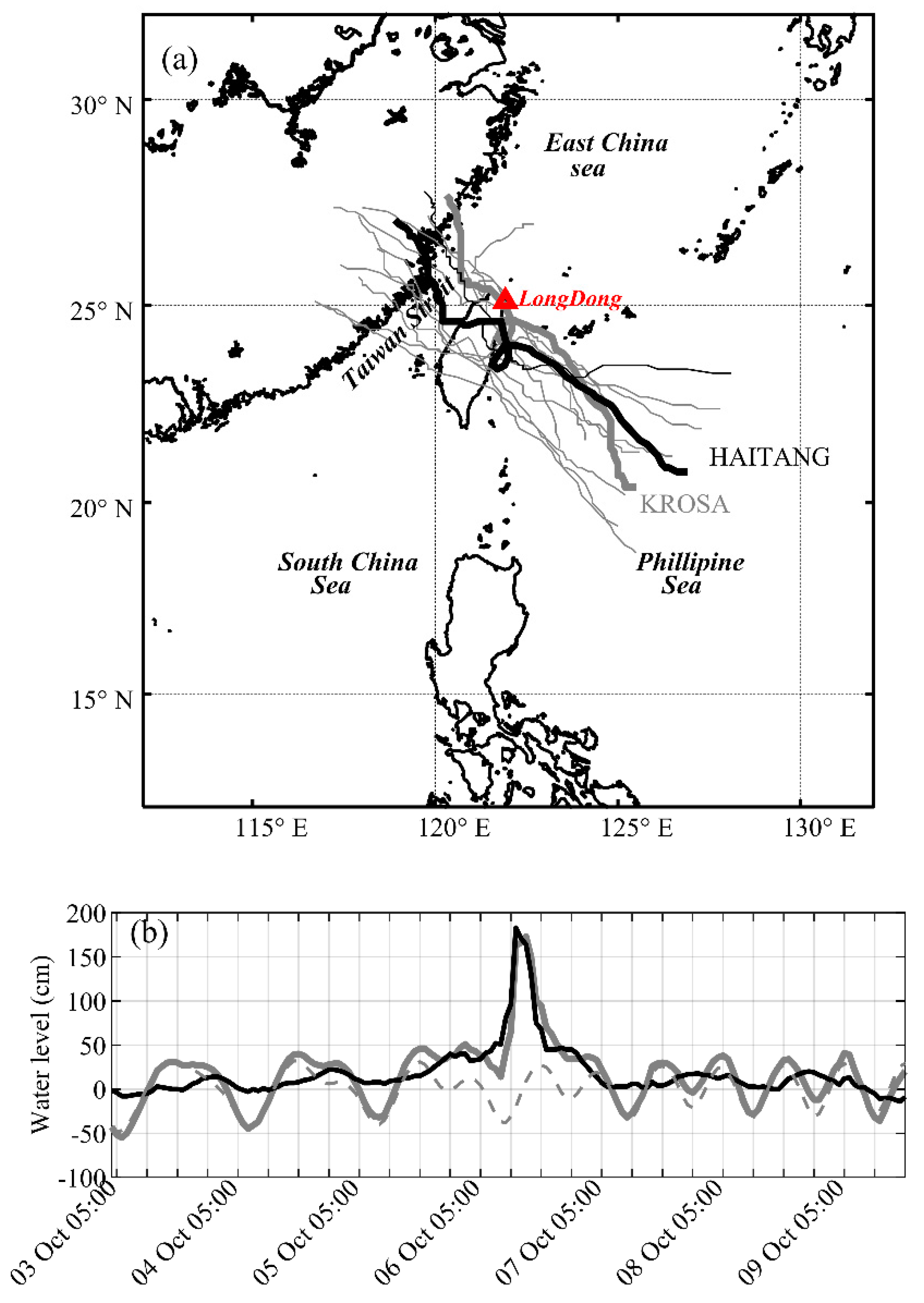
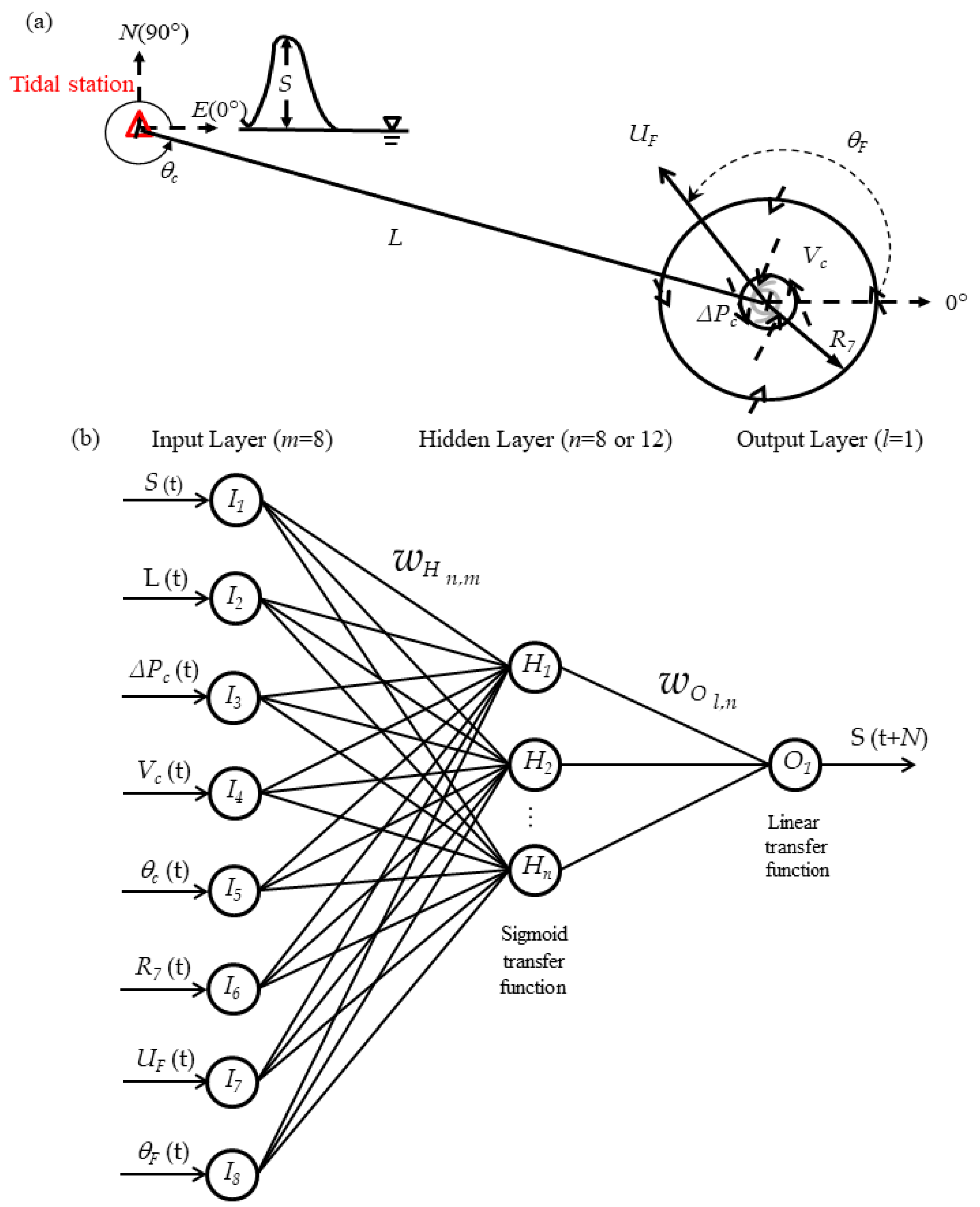
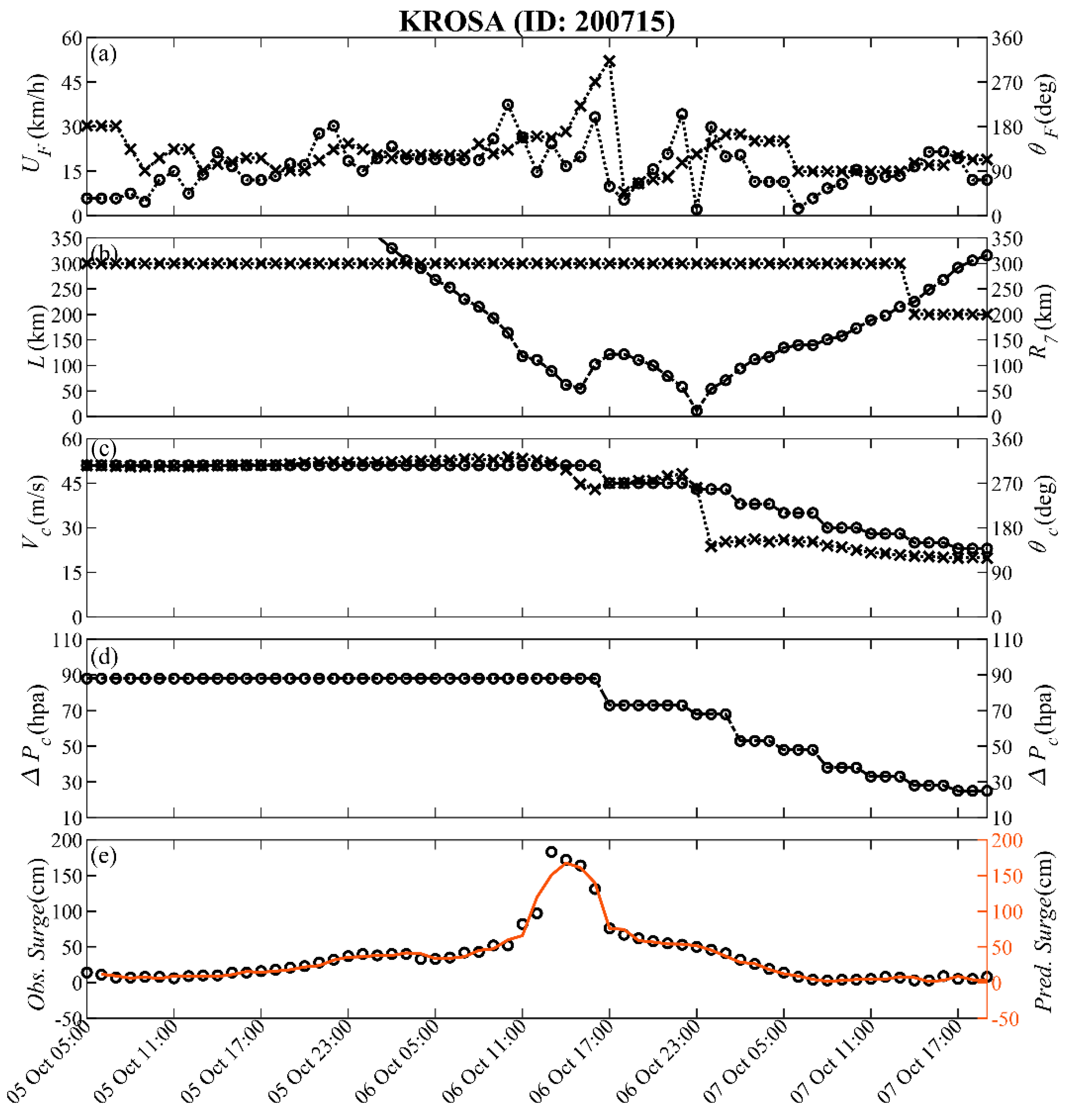
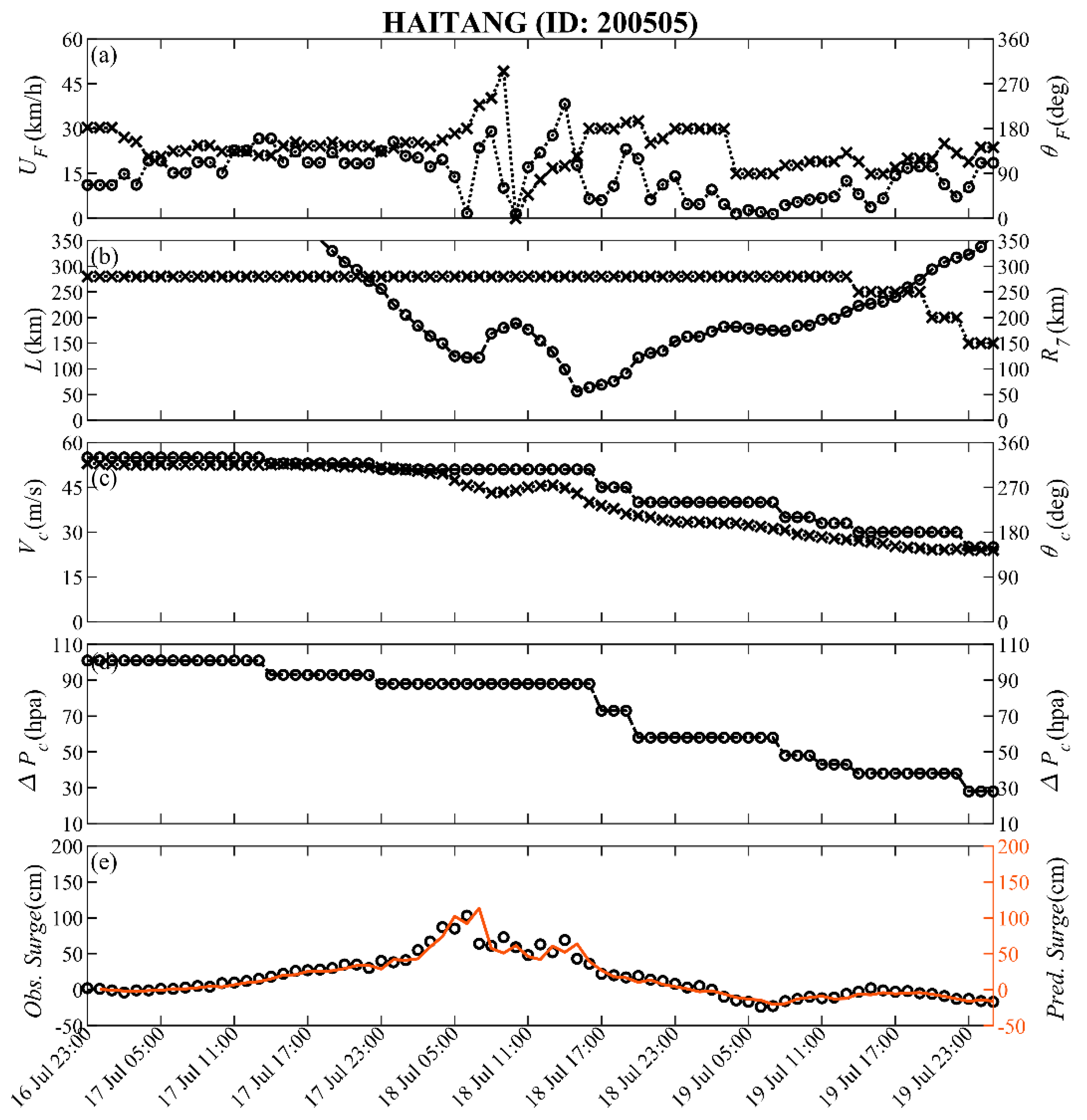
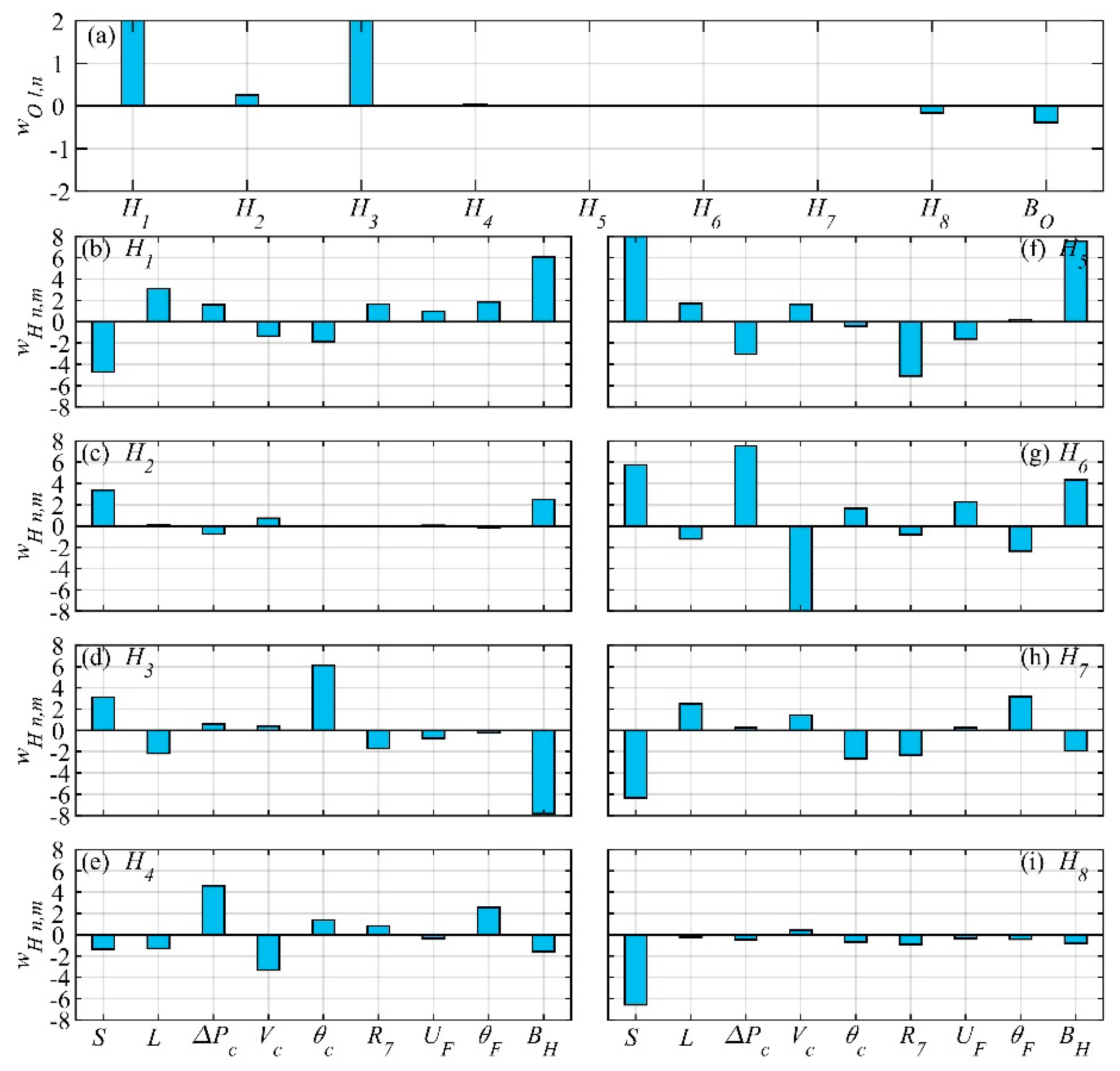
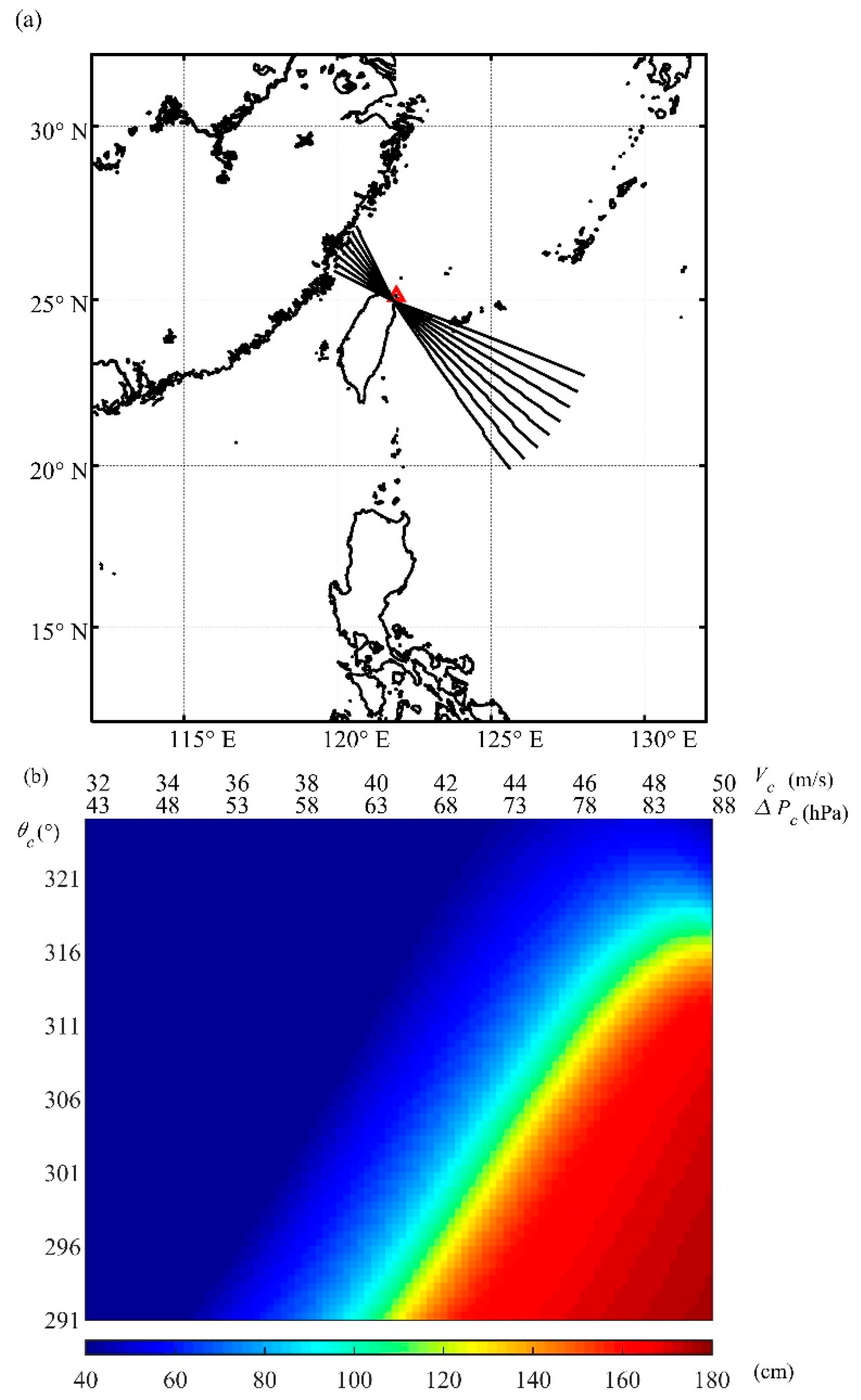
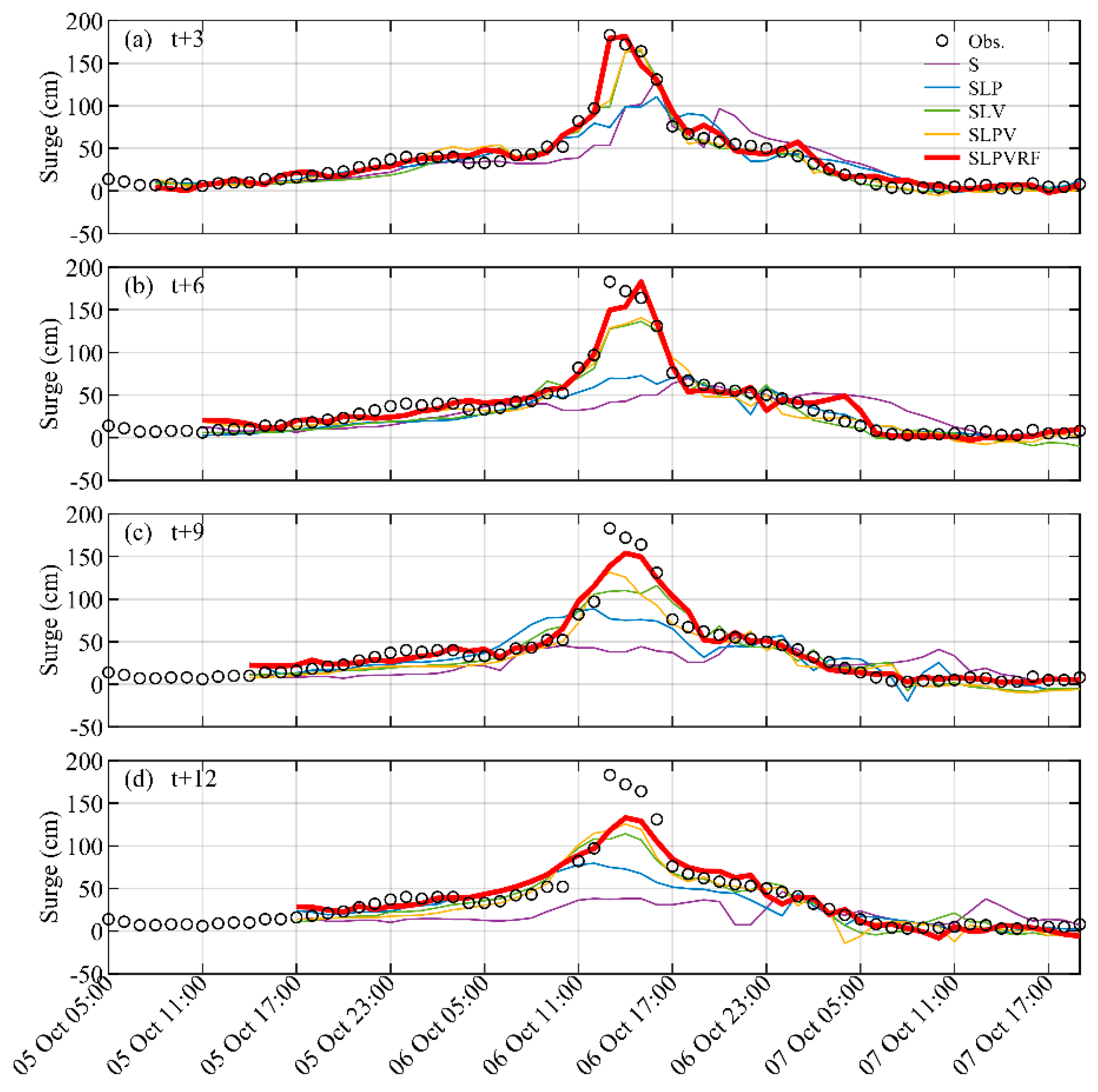
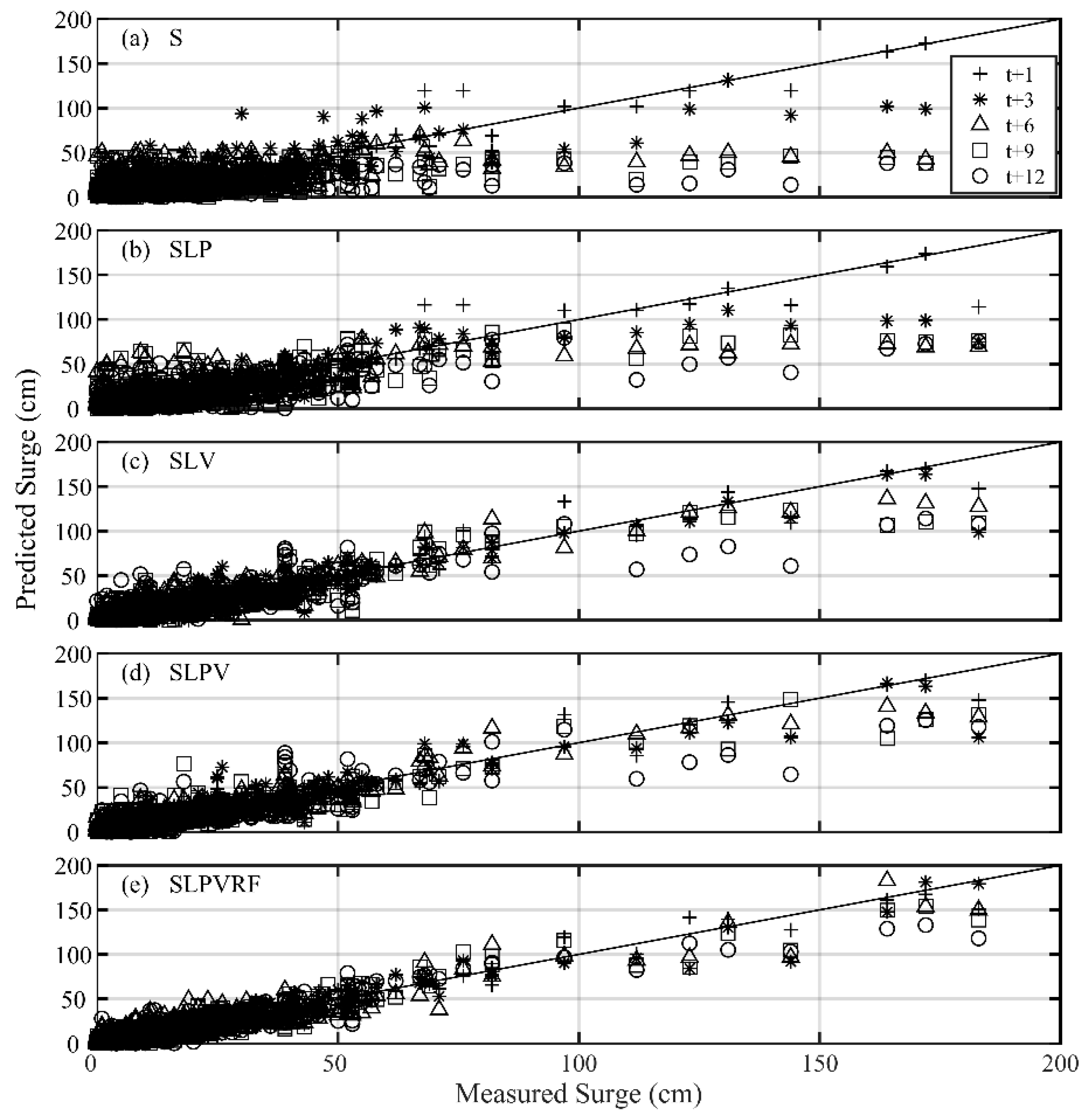
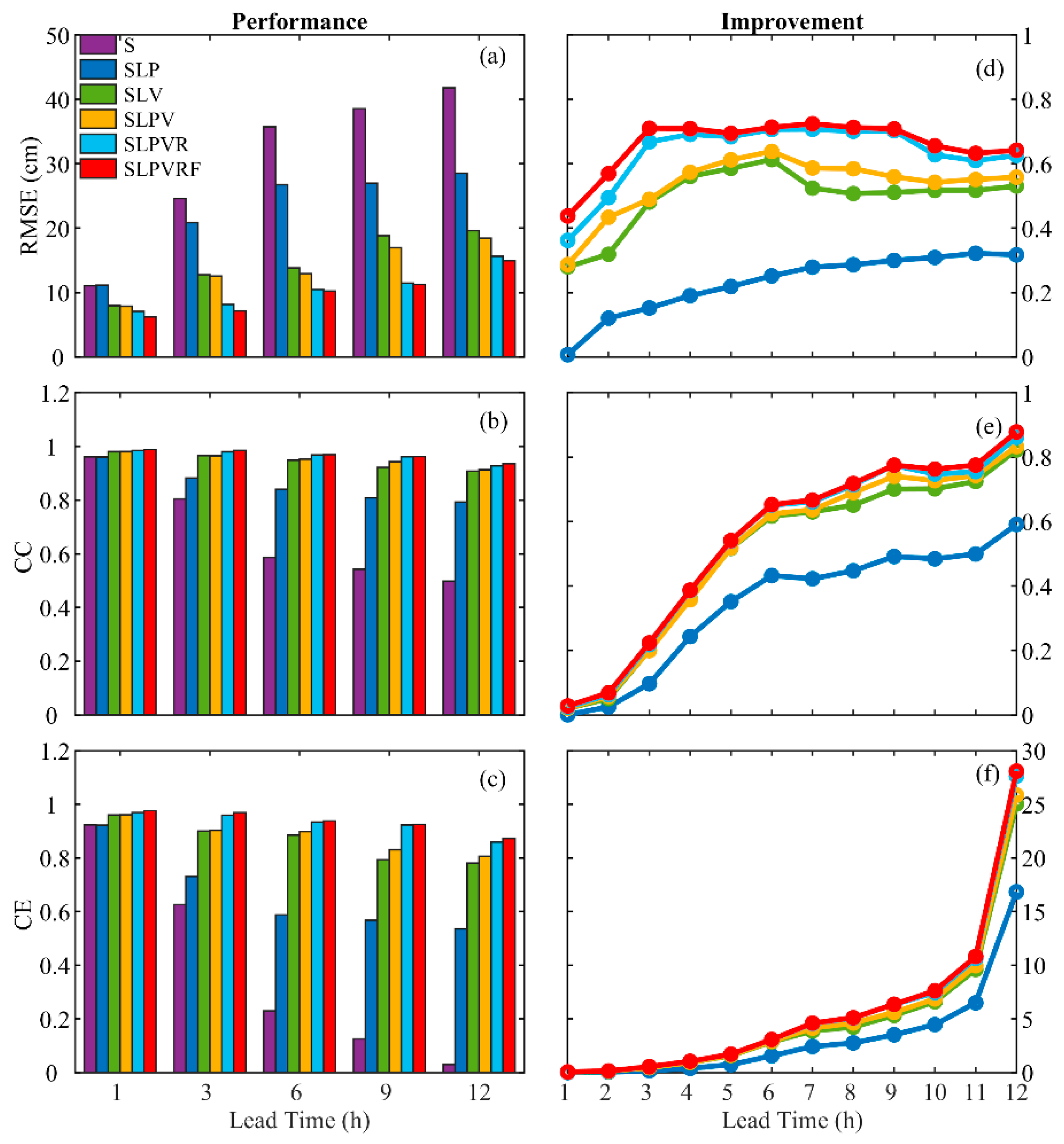
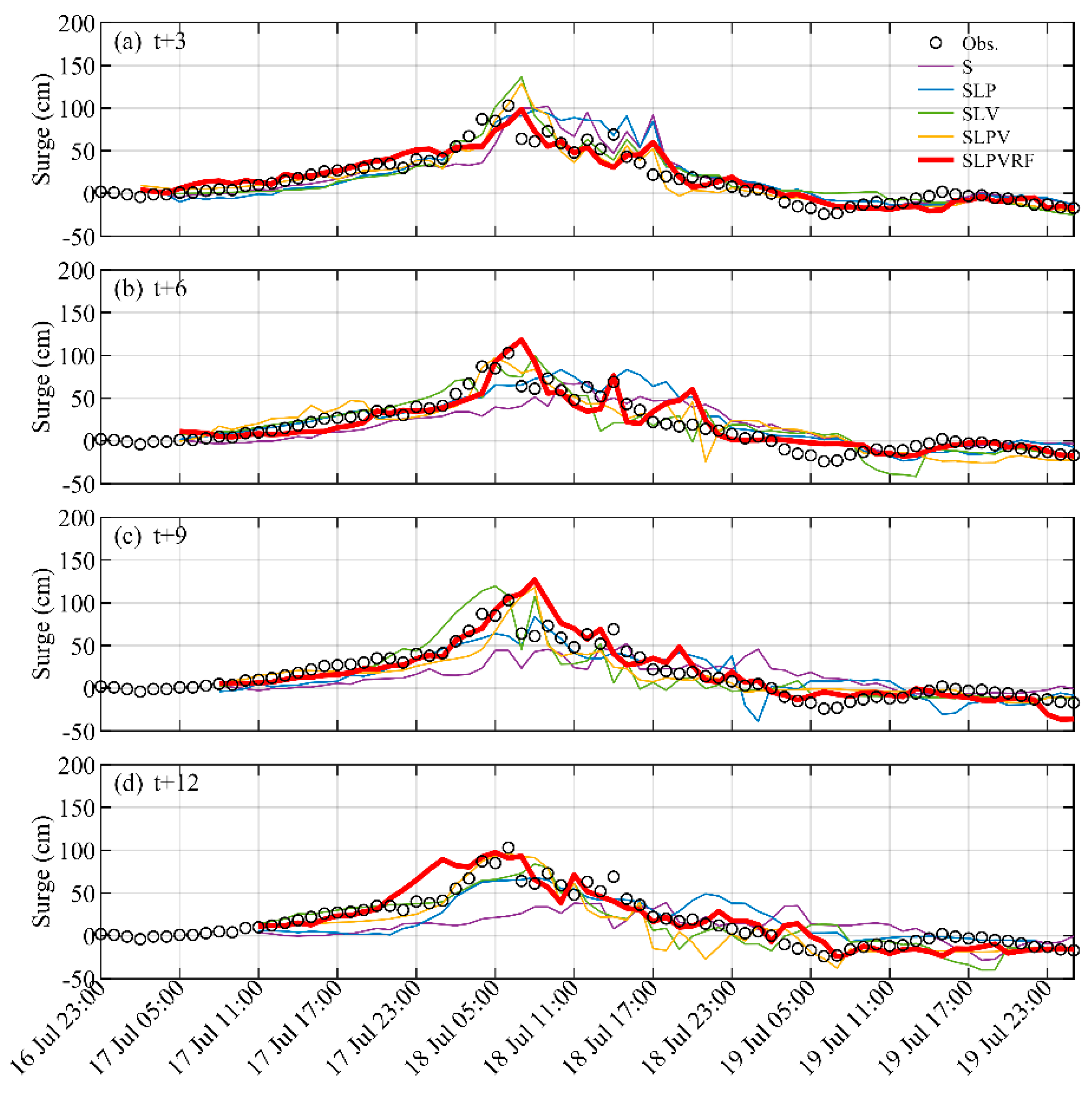
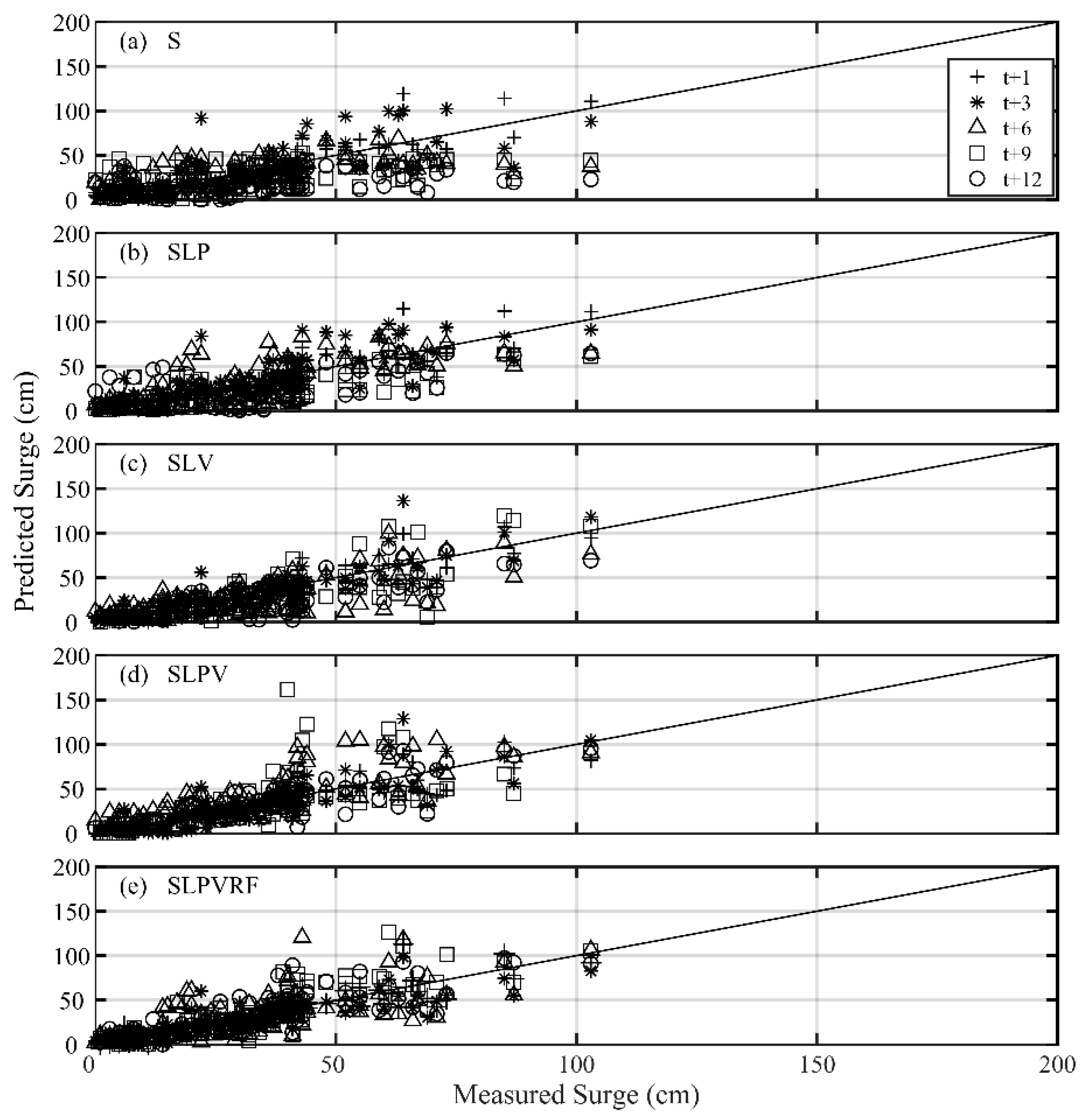
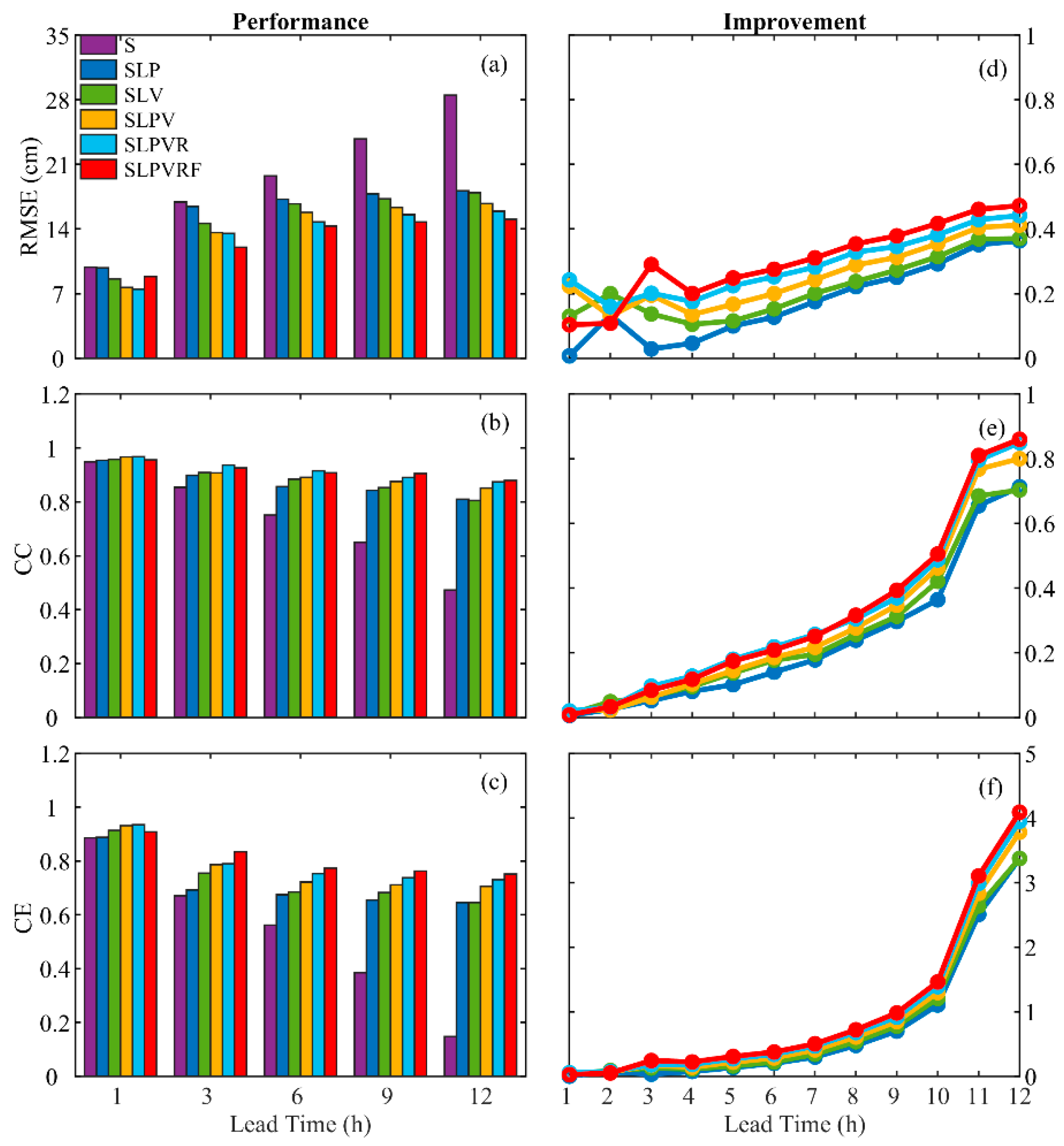
| Name | Year | Track | Pc (hPa) | Vc1 (m/s) | R7 (km) | Max. S (cm) |
|---|---|---|---|---|---|---|
| Haitang 2 | 2005 | 3 | 912 | 55 | 280 | 103 |
| Talim | 3 | 920 | 53 | 250 | 144 | |
| Longwang | 3 | 925 | 51 | 200 | 44 | |
| Bilis | 2006 | 2 | 978 | 25 | 300 | 41 |
| Kaemi | 3 | 960 | 38 | 200 | 15 | |
| Sepat | 2007 | 3 | 920 | 53 | 250 | 20 |
| Krosa | 2 | 925 | 51 | 300 | 183 | |
| Kalmaegi | 2008 | 2 | 970 | 33 | 120 | 23 |
| Fungwong | 3 | 948 | 43 | 220 | 43 | |
| Sinlaku | 2 | 925 | 53 | 280 | 53 | |
| Morakot 2 | 2009 | 3 | 955 | 40 | 250 | 71 |
| Soala | 2012 | 2 | 960 | 38 | 220 | 39 |
| Matmo | 2014 | 3 | 960 | 38 | 200 | 11 |
| Type | Input Parameters |
|---|---|
| S | S(t) |
| SLP | S(t), L(t), ∆Pc(t) |
| SLV | S(t), L(t), Vc (t), θc(t) |
| SLPV | S(t), L(t), ∆Pc(t), Vc(t), θc(t) |
| SLPVR | S(t), L(t), ∆Pc(t), Vc (t), θc(t), R7(t) |
| SPVLRF | S(t), L(t), ∆Pc(t), Vc (t), θc(t), R7(t), UF(t), θF(t) |
| Lead Time (h) | |||||||||||||||
|---|---|---|---|---|---|---|---|---|---|---|---|---|---|---|---|
| 1 | 3 | 6 | 9 | 12 | |||||||||||
| RMSE | CC | CE | RMSE | CC | CE | RMSE | CC | CE | RMSE | CC | CE | RMSE | CC | CE | |
| S | 11.06 | 0.961 | 0.923 | 24.62 | 0.804 | 0.625 | 35.76 | 0.586 | 0.229 | 38.55 | 0.541 | 0.125 | 41.81 | 0.536 | 0.03 |
| SLP | 11.14 | 0.960 | 0.922 | 20.87 | 0.876 | 0.731 | 27.17 | 0.850 | 0.572 | 26.96 | 0.813 | 0.555 | 28.55 | 0.792 | 0.535 |
| SLV | 7.97 | 0.980 | 0.961 | 12.97 | 0.954 | 0.896 | 13.83 | 0.965 | 0.884 | 18.61 | 0.911 | 0.796 | 19.61 | 0.907 | 0.780 |
| SLPV | 7.89 | 0.980 | 0.960 | 12.56 | 0.952 | 0.902 | 12.71 | 0.965 | 0.902 | 16.98 | 0.950 | 0.830 | 18.45 | 0.921 | 0.805 |
| SLPVR | 7.05 | 0.984 | 0.968 | 8.16 | 0.979 | 0.958 | 10.49 | 0.968 | 0.933 | 11.46 | 0.961 | 0.922 | 15.63 | 0.928 | 0.860 |
| SLPVRF | 6.22 | 0.988 | 0.975 | 7.12 | 0.984 | 0.968 | 10.01 | 0.969 | 0.939 | 10.27 | 0.969 | 0.937 | 14.95 | 0.938 | 0.872 |
| Lead Time (h) | |||||||||||||||
|---|---|---|---|---|---|---|---|---|---|---|---|---|---|---|---|
| 1 | 3 | 6 | 9 | 12 | |||||||||||
| RMSE | CC | CE | RMSE | CC | CE | RMSE | CC | CE | RMSE | CC | CE | RMSE | CC | CE | |
| S | 9.86 | 0.948 | 0.886 | 16.92 | 0.853 | 0.670 | 19.75 | 0.751 | 0.561 | 23.76 | 0.647 | 0.385 | 28.50 | 0.472 | 0.147 |
| SLP | 9.79 | 0.954 | 0.887 | 16.44 | 0.884 | 0.689 | 17.02 | 0.854 | 0.674 | 17.94 | 0.816 | 0.654 | 18.14 | 0.809 | 0.645 |
| SLV | 8.58 | 0.958 | 0.913 | 14.60 | 0.897 | 0.754 | 16.75 | 0.865 | 0.684 | 17.37 | 0.852 | 0.671 | 17.47 | 0.850 | 0.670 |
| SLPV | 7.66 | 0.966 | 0.931 | 13.62 | 0.907 | 0.786 | 15.74 | 0.903 | 0.721 | 16.35 | 0.868 | 0.708 | 16.75 | 0.851 | 0.705 |
| SLPVR | 7.41 | 0.967 | 0.934 | 13.52 | 0.898 | 0.789 | 14.66 | 0.936 | 0.758 | 15.54 | 0.915 | 0.736 | 15.80 | 0.874 | 0.737 |
| SLPVRF | 8.85 | 0.955 | 0.908 | 12.01 | 0.916 | 0.834 | 14.21 | 0.913 | 0.773 | 14.92 | 0.906 | 0.757 | 15.04 | 0.889 | 0.750 |
© 2020 by the authors. Licensee MDPI, Basel, Switzerland. This article is an open access article distributed under the terms and conditions of the Creative Commons Attribution (CC BY) license (http://creativecommons.org/licenses/by/4.0/).
Share and Cite
Chao, W.-T.; Young, C.-C.; Hsu, T.-W.; Liu, W.-C.; Liu, C.-Y. Long-Lead-Time Prediction of Storm Surge Using Artificial Neural Networks and Effective Typhoon Parameters: Revisit and Deeper Insight. Water 2020, 12, 2394. https://doi.org/10.3390/w12092394
Chao W-T, Young C-C, Hsu T-W, Liu W-C, Liu C-Y. Long-Lead-Time Prediction of Storm Surge Using Artificial Neural Networks and Effective Typhoon Parameters: Revisit and Deeper Insight. Water. 2020; 12(9):2394. https://doi.org/10.3390/w12092394
Chicago/Turabian StyleChao, Wei-Ting, Chih-Chieh Young, Tai-Wen Hsu, Wen-Cheng Liu, and Chian-Yi Liu. 2020. "Long-Lead-Time Prediction of Storm Surge Using Artificial Neural Networks and Effective Typhoon Parameters: Revisit and Deeper Insight" Water 12, no. 9: 2394. https://doi.org/10.3390/w12092394
APA StyleChao, W.-T., Young, C.-C., Hsu, T.-W., Liu, W.-C., & Liu, C.-Y. (2020). Long-Lead-Time Prediction of Storm Surge Using Artificial Neural Networks and Effective Typhoon Parameters: Revisit and Deeper Insight. Water, 12(9), 2394. https://doi.org/10.3390/w12092394








